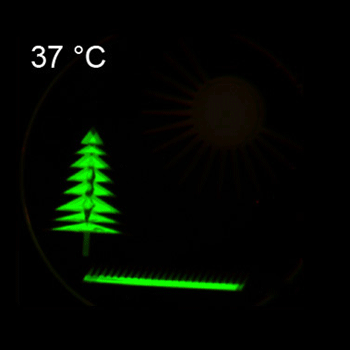Now, a new study performed using mice demonstrates how doctors might one day better regulate those therapeutic microbes by engineering them to respond to temperature. For instance, if engineered bacteria were administered to a patient with a disease, doctors could, in theory, instruct the bacteria to release medicine to just the site of interest, and nowhere else in the body, by using ultrasound to gently heat up the tissue.
«Bacteria can be designed to act like special agents fighting disease in our bodies," says Caltech’s Mikhail Shapiro, assistant professor of chemical engineering and Heritage Principal Investigator, whose overall research goal is to create new ways to both visualize and control
Shapiro is principal investigator on a paper about the new research published November 14 in the journal Nature Chemical Biology. The colead authors are Dan Piraner and Mohamad Abedi, graduate students in Shapiro’s lab.
The research also shows how these engineered bacteria, once in a patient, could be programmed to stop administering a therapeutic or to
In another application of the technology, the researchers demonstrated how the bacteria could be designed to destroy themselves once they leave a patient’s body through defecation. The lower temperature outside of a host’s body would signal the engineered bacteria to activate a genetic kill switch, thereby alleviating concerns about the genetically altered microbes spreading to the environment.
«We can use these thermal switches in bacteria to control a variety of behaviors," says Shapiro.
The strategy of using engineered bacteria to fight
The method developed by Shapiro’s lab solves this problem by providing a mechanism through which bacteria can be instructed to direct drugs only to a specific anatomical site. The idea is that the genetically engineered bacteria would activate their therapeutic program at a certain temperature induced via ultrasound tools, which gently heat tissues with millimeter precision. A doctor could, in theory, administer genetically altered bacteria to a cancer patient and then, by focusing ultrasound at the tumor site, trigger the bacteria to fight the tumor.
«We can spatially and temporally control the activity of the bacteria," says Abedi. «We can communicate with them and tell them when and where something needs to be done.»
To create thermally controllable bacteria, the team first needed to find candidate genetic switches whose activity depends on temperature changes. They ultimately identified two candidates. The first is a protein in Salmonella bacteria, and the second originates from a bacterial virus called a bacteriophage. Both proteins bind to DNA to turn a genetic circuit on or off in response to temperature.

The glowing images in this animation were drawn on petri-dish plates with bacteria. The bacteria were engineered to respond to temperature changes. The bacteria seen in the tree express green fluorescent protein at temperatures above 36 degrees Celsius. Bacteria seen in the sun express a red fluorescent protein above 40 degrees Celsius. Bacteria in the lawn have both the green and red thermal switches, and thus turn yellow at the higher temperatures. (Image credit: Shapiro Lab/Caltech)
«When we were thinking about how to get bacteria to sense temperature, we looked at nature and found a few systems where bacteria can do this," says Piraner. «We tested the performance, found the ones that had the best switching performance. From there, we went on to find that they could be tuned and amplified. It all started with what nature gave us, and engineering took us the rest of the way.»
The study, titled, «Tunable Thermal Bioswitches for In Vivo Control of Microbial Therapeutics," was funded by the Defense Advanced Research Projects Agency, the Weston Havens Foundation, the Burroughs Wellcome Career Awards at the Scientific Interface, and the Heritage Medical Research Institute as well as through graduate fellowships from the National Science Foundation and the Paul and Daisy Soros Fellowship for New Americans. Other Caltech coauthors are Brittany Moser, now a PhD student at UC Irvine, and research technician Audrey Lee Gosselin.
Source: http://www.caltech.edu/news/biologists-give-bacteria-thermostat-controls-52968


